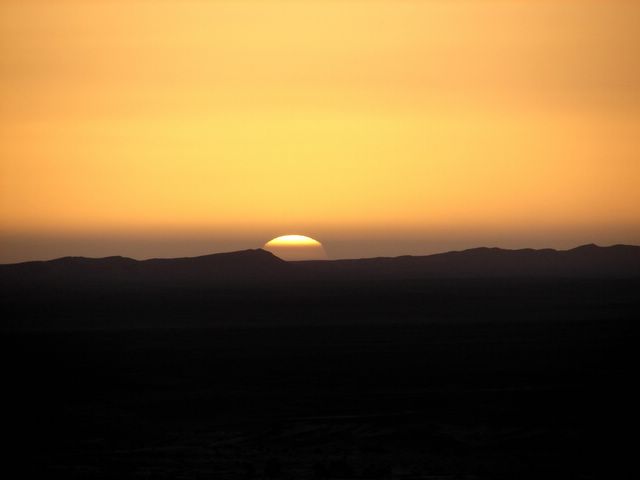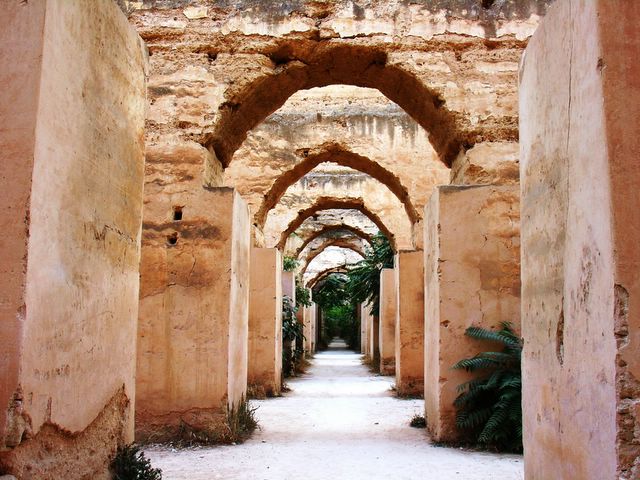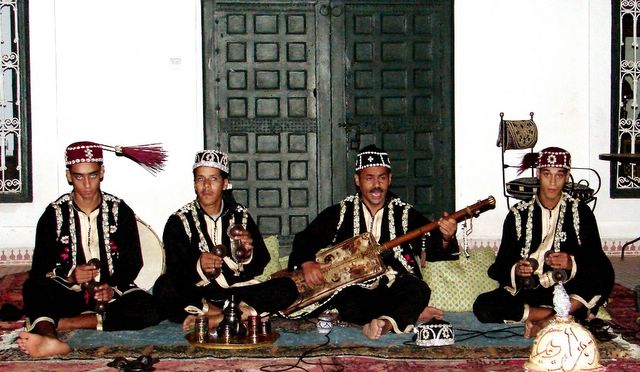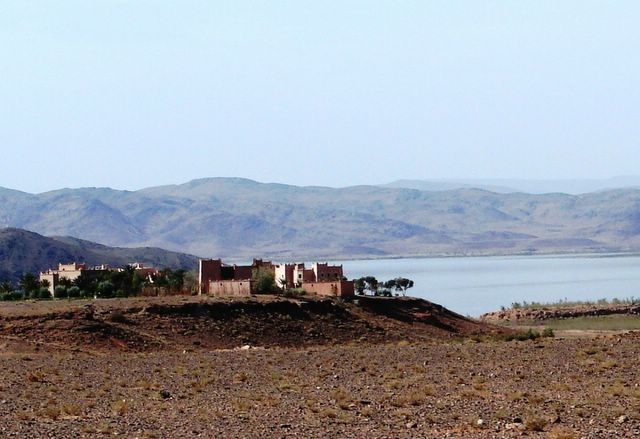The Amazigh: Returning from the Ashes of Neglect II
Part II - What the Amazigh (Berbers) Want
Note that the native people of North Africa call themselves 'Amazigh' (sing.) or Imazighen (plur.), which means 'Freemen'. They refer to their language as 'Tamazight' and their homeland in North Africa as 'Tamazgha'. The name 'Berber' was imposed upon them by the Romans who followed the Greek custom of designating speakers of unintelligible languages as 'barbarians'.
 Five years ago, a group of Amazigh Intellectuals headed by a prominent scholar and former teacher of the current King of Morocco produced a document called The Amazigh Manifesto; a document that has come to symbolize the official rebirth of the Amazigh movement. The Amazigh people were finally intent to forego their silence and openly challenge the status quo in order to regain their rights and obtain redress for the many years of discrimination they have suffered under Arab regimes in their homeland of North Africa. It was finally time for the Amazigh people to denounce the unjust treatment they have suffered and the systematic repression they have endured.
Five years ago, a group of Amazigh Intellectuals headed by a prominent scholar and former teacher of the current King of Morocco produced a document called The Amazigh Manifesto; a document that has come to symbolize the official rebirth of the Amazigh movement. The Amazigh people were finally intent to forego their silence and openly challenge the status quo in order to regain their rights and obtain redress for the many years of discrimination they have suffered under Arab regimes in their homeland of North Africa. It was finally time for the Amazigh people to denounce the unjust treatment they have suffered and the systematic repression they have endured.What follows is a summary of demands outlined in the The Amazigh Manifesto. Since the publication of this document, the Moroccan Monarch responded favorably to some of the Amazigh demands. This includes the creation of an Amazigh Cultural Institute and the teaching of the Amazigh language at the primary level of the school system. However, many of the fundamental demands of the Amazigh people are still unsatisfied, including the recognition of the Amazigh language as an official language of the country, lifting the ban on registering Amazigh names, and the economic development of Amazigh-speaking areas. While some of the initiatives taken recently by the King of Morocco are positive, the Amazigh people of North Africa continue to suffer systematic discrimination and premeditated repression.
First Request
The government must make the issue of the Amazighity of Morocco the subject of a large-scale national debate. Some of the political parties have the duty of educating those of their followers who were brought up to be fanatical about Arab nationalism and the denial of the "Amazighity" of Morocco.
The government has at its disposal all the State’s financial and logistical means in the domains of mass media, education and culture and the freedom to act as the official organizer and moderator of the much needed debate.
Second Request
It is high time that the recognition of our original national language–Tamazight (i.e. Berber)–as an official language be enshrined in the country’s Constitution.
Third Request
There is no gainsaying the historical reality, which indeed can not be contested, that the economic and cultural marginalization of the Amazighs since 1912 has brought about their political weakness. Thus, they have been largely exploited by the political Right and Left alike.
Therefore, we demand that a serious planning for the economic development of the Amazighs- speaking areas take place, with the aim to give them momentary priority to get equipped with the necessary infrastructure.
Fourth Request
The Amazighs are strongly attached to their linguistic heritage, more so than to a material one. This is because they are Amazigh thanks to their language not to their race. They are completely aware of the fact that whoever among them exposes his language to loss is doing the same to his Amazigh existence.
Thus, we are asking the government to prepare draft bills aiming to enforce the teaching of Tamazight in schools, institutes and universities. Moreover, we request that it create the scientific institutions capable of codifying the Amazigh language and preparing the pedagogical instruments necessary for its teaching.
Fifth Request
In the last 40 years, the political trends that have adopted a fanatical stand about Arabism have exploited their effective hegemony and used their authority to orient historical studies on the Maghreb and the teaching of History in accordance with their wishes and ideological inclinations.
For these reasons, we demand that a serious reconsideration of the kind of history taught to our children take place. To achieve this objective, a "National Scientific Commission" must be set up, at the highest possible level, and charged with the task of devising the History syllabi, particularly for the primary, junior and high school levels. Our ministers of education shall not be given free disposal as concerns syllabi and curricula in the field of History.
Sixth Request
We call upon the government to make the use of Tamazight mandatory in public service, for the benefit of those of our fellow citizens who are not cognizant in Arabic.
The official mass media should be in the service of the Amazighs in the same way that they are for other citizens. This would be achieved only by the creation of a "Radio and TV station" where the linguistic medium used is mainly Tamazight.
The State has to create a training institution for translators and interpreters in Tamazight to be employed in the court system, the administrations, the hospitals and all the public services.
The government should allow the use of Tamazight in the proceedings of official meetings, at least at the level of local and regional councils.
The government must lift the ban on registering the Amazigh names in the Sate Registry Services as soon as possible, because in this ban lies a clear intention to provoke the Amazighs.
Seventh Request
The original Amazigh art is to be rehabilitated. This includes literature, dancing, singing, architecture and decoration. This art is to be modernized so that it will be improved and promoted. The Amazigh artists must be granted the same financial assistance and endowments as their Arab colleagues.
Eighth Request
The authorities must cease to intentionally distort the Amazigh names of places, villages, cities and regions, through their arbitrary Arabization, as this increases the resentment of the Amazighs.
Ninth Request
The Amazigh cultural associations are to be granted the status of "Public Interest" associations so as to enable them to benefit from State financial assistance.
The newspapers, magazines and all publications concerned with the defense and promotion of the Amazigh heritage of Morocco are to be given the same financial help as that made available for publications in Arabic and the foreign languages.
See Also:
.


























13 Comments:
To which linguistic group does Tamazight actually belong? Do the Amazigh living in France and other places practice their own culture at least to seme extent?
February 23, 2005
To answer your first question about the linguistic group that Tamazight belongs to, let me start by saying that it is an ancient language. As I pointed out in the first part of my article series, the presence of the Amazigh people in North Africa can be traced back to 5000 BC. The oldest proof of their writing was discovered by Archeologists in the Atlas Mountains and dates back to around 1000 BC. There are several theories being entertained about the origins of the language but none are backed by undisputable evidence.
All of the civilizations that invaded Amazigh land, tried to oppress Imazighen through the suppression of their language. That struggle continues and many Amazigh intellectuals today are trying to resurrect the language in its pure form and free it from the distortions introduced by mostly Latin, Arabic, and Turkish invasions. To get a glimpse of the Amazigh language (referred to as Tifnagh), visit: http://www.kasbahitran.com/kasbah_en/03cultura
/Cultura.html and click on the thumbnail table on the right side of the page.
Regarding your second question, it is actually a perfect segway to my next article. As you may have noticed, I am writing a series of articles under the heading "The Berbers: Returning from the Ashes of Neglect". But to answer your question quickly, Imazighen who live in Europe (i.e., France), especially the younger generation, are actually one of the biggest reasons behind the renaissance of the Amazigh movement. They are very much attached to their heritage and unlike their oppressed ancestors, they are much more educated and, something else they have going for them; they live in democratic societies. So, they are very much in the forefront of the struggle.
February 23, 2005
WOW this is really great! I am really impressed with your knowledge on the subject.
The thing I'm wondering about though is how many people do actually speak tifnagh today? And why teach tifnagh as the official Berber language when there are several other prominent Amazigh dialects spoken today that clearly differ from one and other? I personally had never heard of Tifnagh till about 2 years ago.
For instance I speak thmazight of the north (note how I added the h after the t and no a after the h) and my sister-in-law from Agadir speaks tamazight from Sous, our languages are so different that we're not even able to converse with each other in the slightest bit, same thing with the Amazigh of the Atlas.
So is this all about the revival of the original language and not necessarily the recognition of the Amazigh languages that have evolved from it?
I'm just asking these questions because I'm truly trying to undesrtand how this is all going to work. And of course I welcome the changes with open arms. (:
February 23, 2005
First, I have to correct myself on something I said that may mislead some people. Tifnagh is a reference to the Amazigh alphabet, not the language. There are some slight variations of this alphabet. But Tifnagh is the standard and it is the alphabet adopted by the Moroccan Royal Institute for the Amazigh Culture (IRCAM) and endorsed by international Amazigh organizations.
Regarding the different Amazigh dialects in existence, this is the legacy of the 'Divide and Conquer' strategies that were adopted by invaders all the way to the French in the first half of the 20th century. In Morocco, for instance, as you well point out, there are three major groups: Tarifit (North), Tamazight (Atlas), and Tachelhit (South or Souss). Then in Algeria you have Kabylie. Other groups of Imazighen also live in Niger, Mali, Libya, and Tunisia. They all have somewhat of a different dialect. But they also all have words in common, like the word for 'bread'='Aghroum' and 'water'='Amane'. That is why the Amazigh Intellectuals are frantically trying to rescue what is left of the ancient heritage of the Amazigh people.
One other note. The argument that there are different dialects in Amazigh is what is being used today by Arab nationalists to deny the Amazigh their right to have their language recognized. It is like having someone force you to make a bat and beat you with it afterwards. That is why the work done by Amazigh intellectuals like Mohamed Chafik to reunify the language is so important. I can tell you one thing, this is an issue that unifies the entire Amazigh nation from Morocco to Egypt. Because after all, as the Amazigh Manifesto explains: "The Amazighs are strongly attached to their linguistic heritage, more so than to a material one. This is because they are Amazigh thanks to their language not to their race."
February 23, 2005
But if the dialects are so different how can they be reconciled? Is there a standard version of the language, just like there's Modern Standard Arabic, despite all the dialects thereof?
February 23, 2005
This comment has been removed by a blog administrator.
February 23, 2005
First, thank you so much for your interest in this topic. To answer your question directly, Yes there is a unified language. The problem is that unlike other languages, it is poorly recorded and the divisions that were forced upon the Amazigh people exasperated that problem. Not to forget that the Amazigh were condemned to remote areas with no access to resources and tools that would unable them to develop their language. But that is what Amazigh scholars are trying to do now. They are resurrecting the classical native language of the Amazigh and re-educating their entire community about it. Not an easy task, but one that is necessary if the Amazigh people were to survive the test of time.
One other thing, what is fascinating about this whole thing is that although dividing the Amazigh took a toll on their common native language, it did very little damage to their common value system! They may have changed a word here and there, but they passed their beliefs and values intact from generation to generation.
February 24, 2005
Thanks for all the efforts you put into this, Jawad. I have learned so much from your insightful articles.
I went digging for an article a friend had sent to me several months ago. I thought I' share...
------------------
Ruins Suggest Berber Civilization Is Older
From L.A. Times staff and wire reports
August 21, 2004
The remains of a Berber town believed to date back 15,000 years have been discovered in Western Sahara, Moroccan state media said Thursday. Berber civilization had been believed to date back 9,000 years.
Moroccan scientists found remains of a place of worship, houses and a necropolis in the ruins of Arghilas near Aousserd.
February 24, 2005
Thank you for answering! I became interested in this issue after reading Merzak Allouache's "Bab el-Oued" and watcing the film, though both mentioned the Kabylia region only in passing. How do the Amazigh manage to pass down the values? Do they have written texts on ethics?
February 25, 2005
Two ways to answer your question. I hope to also answer an earlier question you asked about the Amazigh faith that I forgot to address.
1. The Amazigh have maintained a customary legal system over thousands of years in North Africa covering all aspects of life. They had written laws that regulated the individual, collective, cultural and political life of their people. It also provided for a property rights system (ownership of lands, forests, water and minerals). Note that the Amazigh tribes were organized in confederations according to land ownership and natural boundaries that allowed for their mutual defense. That system was passed on in written form to the next generations of Imazighen. Here are a few highlights from testimony to the United Nations by Amazigh orgs:
“The Amazigh system of justice in most tribes was based on the principle of respect of life. Accordingly, this system does not recognize the death penalty. In fact, the utmost penalty was the exile outside the tribe. It was based on the principle of financial instead of physical penalties.”
“In many regions, the Tamazalt Right was adopted in the case of divorce. This right allows the married couple to divide between them the wealth acquired by the husband or by both of them after marriage until the divorce or death occurs.”
“The judges were usually appointed among pious men of the tribe to carry out the duties of judges or wise men (Inflas or Aït Rïin). They were in charge of listening to litigants who explain all events and defend themselves in the Tamazight language then judgments are passed.”
2. The Amazigh people follow a mystical form of Islam. Sufism has undoubtedly a big role to play in the Amazigh faith. But they also have some customs that are very close to the Shiite sect. For instance, they celebrate Achoura (a Shiite tradition). They also hold several celebrations and pelgrimages (called Moussems) in a way that is similar to what you'd see in Najaf and Karbala (Shiite towns). They also defer greatly to the words of their religious leaders and the legacies of their local saints. That hierarchical deity system is more like Catholicism and Shiite Islam than Sunni Islam as experienced in Arabia. And that is the second part of my answer to your original question. Some of those values were passed on through the writings and teachings of tribal religious leaders who had and continue to have a great influence upon their communities, even on those expatriates who now live in western countries. Many of them never fail to go back to pay their respects to their current tribal religious leaders and visit the shrines of their local saints.
Also, Thank you Myrtus for sharing that news piece. Goes to show you that just when we think we know something, we find out there is more.
February 25, 2005
Thank you! This is very interesting! Hmm... But how complex it must be to reconcile two differing branches of Islam, and to integrate it with the non-religious cultural aspects of life!
February 26, 2005
Why not reconstruct the ancient language of Tamazight and use it instead of the various dialects, some of which cannot be mutually understood? Is the root word Tamaz a version of the ancient Semitic deity Tamuz? If so, how did that happen and why?
December 25, 2006
Thank you for your comment.
On the first point, the reason is one of practicality – or lack thereof. To reconstruct the ancient language is a nice thought - but it's not practical. Remember that the divisions (geographic, historical, social, and political) are real and are not to be underestimated. The other thing is that the Amazigh have a strong national identity vis-à-vis where they live. The Moroccan Amazigh feel strongly about their Moroccan identity - same applies for those in Algeria. It would take a remarkably charismatic and powerful force to transcend history and unify the tribes of Tamazgha – a feat, by the way, that has never been achieved even before the Amazigh land was conquered.
On your second point, I simply don’t know. I am not a linguistics expert and unfortunately I have no knowledge of Tamuz. In fact, this is the first time I hear of it (pardon my ignorance). It would be great if you can share some more on this.
December 26, 2006
Post a Comment
<< Home